Analyzing Imbalances in Australian Enterprise Industrial Relations
VerifiedAdded on 2021/05/31
|9
|2130
|23
Essay
AI Summary
This essay provides an in-depth analysis of industrial relations, specifically focusing on the Australian context. It explores the relationship between employers and employees, highlighting the challenges and imbalances within the system. The essay discusses the role of the Fair Work Act 2009, employer associations, and unions in shaping workplace dynamics. It examines issues such as wage fixing, economic growth, and the impact of industrial relations on business. The author argues that the current system is unbalanced and calls for changes to address the concerns of both employers and unions. The essay references various sources and provides examples to support its arguments, ultimately advocating for a more balanced industrial relations landscape to foster economic prosperity and productive workplace relationships.
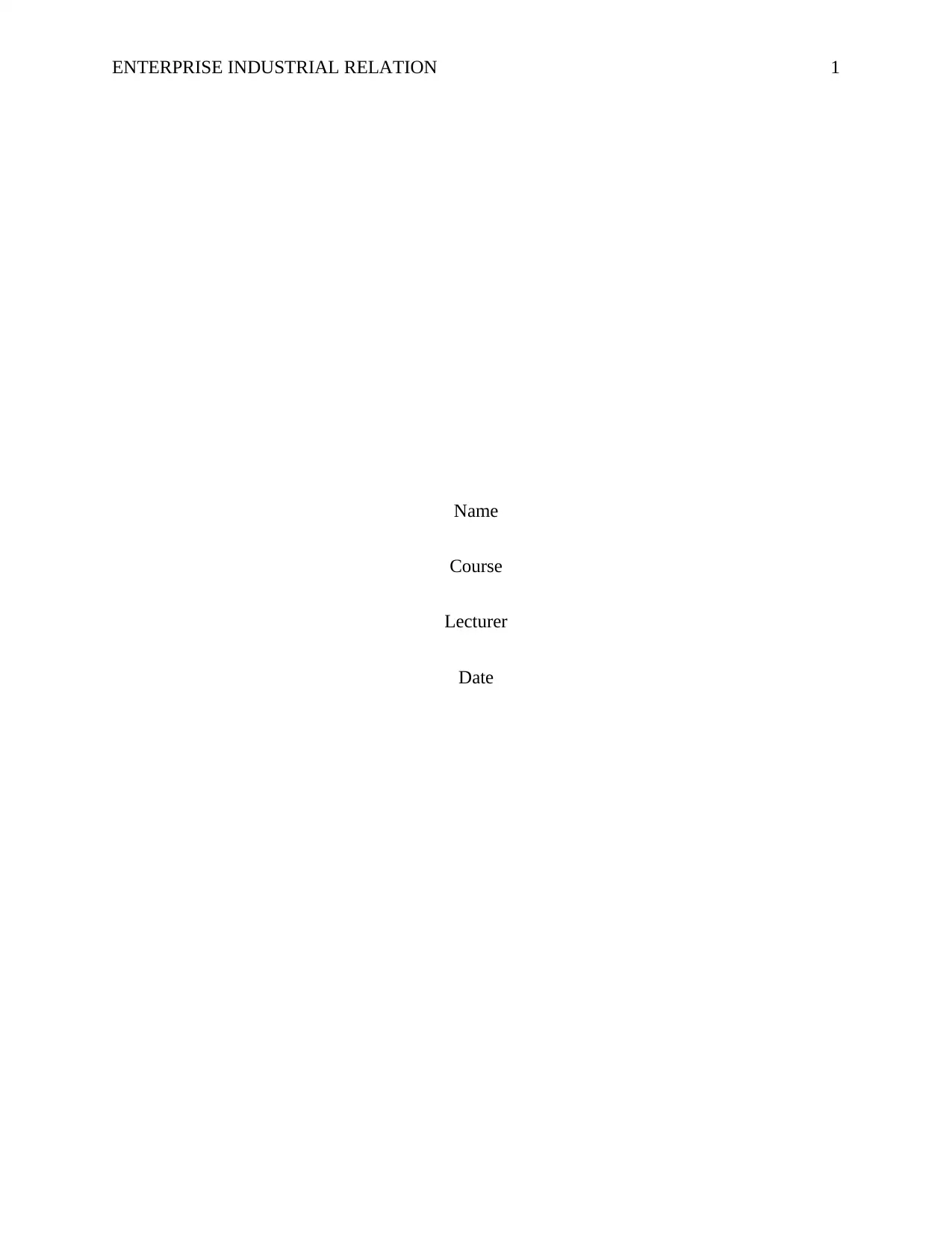
ENTERPRISE INDUSTRIAL RELATION 1
Name
Course
Lecturer
Date
Name
Course
Lecturer
Date
Paraphrase This Document
Need a fresh take? Get an instant paraphrase of this document with our AI Paraphraser
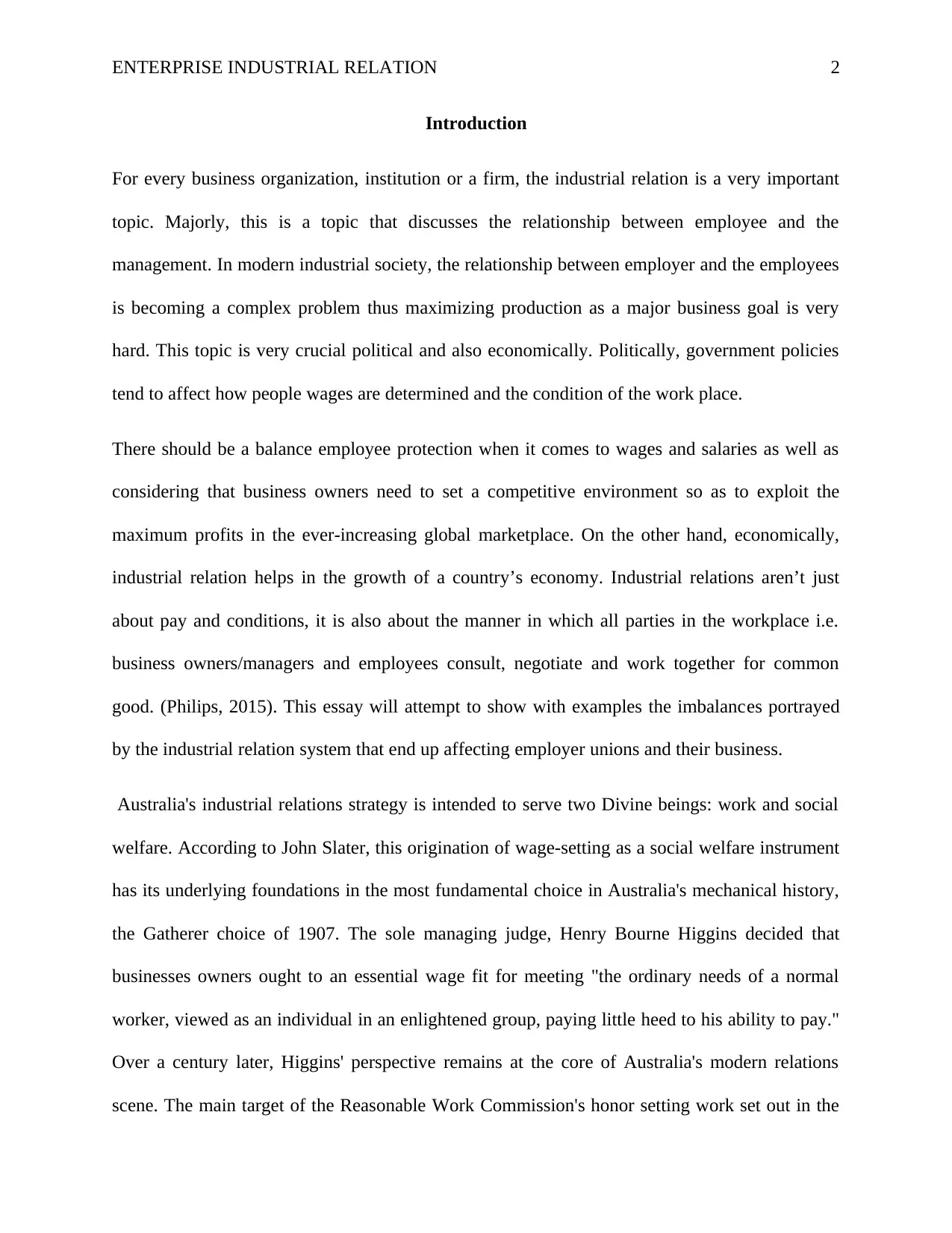
ENTERPRISE INDUSTRIAL RELATION 2
Introduction
For every business organization, institution or a firm, the industrial relation is a very important
topic. Majorly, this is a topic that discusses the relationship between employee and the
management. In modern industrial society, the relationship between employer and the employees
is becoming a complex problem thus maximizing production as a major business goal is very
hard. This topic is very crucial political and also economically. Politically, government policies
tend to affect how people wages are determined and the condition of the work place.
There should be a balance employee protection when it comes to wages and salaries as well as
considering that business owners need to set a competitive environment so as to exploit the
maximum profits in the ever-increasing global marketplace. On the other hand, economically,
industrial relation helps in the growth of a country’s economy. Industrial relations aren’t just
about pay and conditions, it is also about the manner in which all parties in the workplace i.e.
business owners/managers and employees consult, negotiate and work together for common
good. (Philips, 2015). This essay will attempt to show with examples the imbalances portrayed
by the industrial relation system that end up affecting employer unions and their business.
Australia's industrial relations strategy is intended to serve two Divine beings: work and social
welfare. According to John Slater, this origination of wage-setting as a social welfare instrument
has its underlying foundations in the most fundamental choice in Australia's mechanical history,
the Gatherer choice of 1907. The sole managing judge, Henry Bourne Higgins decided that
businesses owners ought to an essential wage fit for meeting "the ordinary needs of a normal
worker, viewed as an individual in an enlightened group, paying little heed to his ability to pay."
Over a century later, Higgins' perspective remains at the core of Australia's modern relations
scene. The main target of the Reasonable Work Commission's honor setting work set out in the
Introduction
For every business organization, institution or a firm, the industrial relation is a very important
topic. Majorly, this is a topic that discusses the relationship between employee and the
management. In modern industrial society, the relationship between employer and the employees
is becoming a complex problem thus maximizing production as a major business goal is very
hard. This topic is very crucial political and also economically. Politically, government policies
tend to affect how people wages are determined and the condition of the work place.
There should be a balance employee protection when it comes to wages and salaries as well as
considering that business owners need to set a competitive environment so as to exploit the
maximum profits in the ever-increasing global marketplace. On the other hand, economically,
industrial relation helps in the growth of a country’s economy. Industrial relations aren’t just
about pay and conditions, it is also about the manner in which all parties in the workplace i.e.
business owners/managers and employees consult, negotiate and work together for common
good. (Philips, 2015). This essay will attempt to show with examples the imbalances portrayed
by the industrial relation system that end up affecting employer unions and their business.
Australia's industrial relations strategy is intended to serve two Divine beings: work and social
welfare. According to John Slater, this origination of wage-setting as a social welfare instrument
has its underlying foundations in the most fundamental choice in Australia's mechanical history,
the Gatherer choice of 1907. The sole managing judge, Henry Bourne Higgins decided that
businesses owners ought to an essential wage fit for meeting "the ordinary needs of a normal
worker, viewed as an individual in an enlightened group, paying little heed to his ability to pay."
Over a century later, Higgins' perspective remains at the core of Australia's modern relations
scene. The main target of the Reasonable Work Commission's honor setting work set out in the
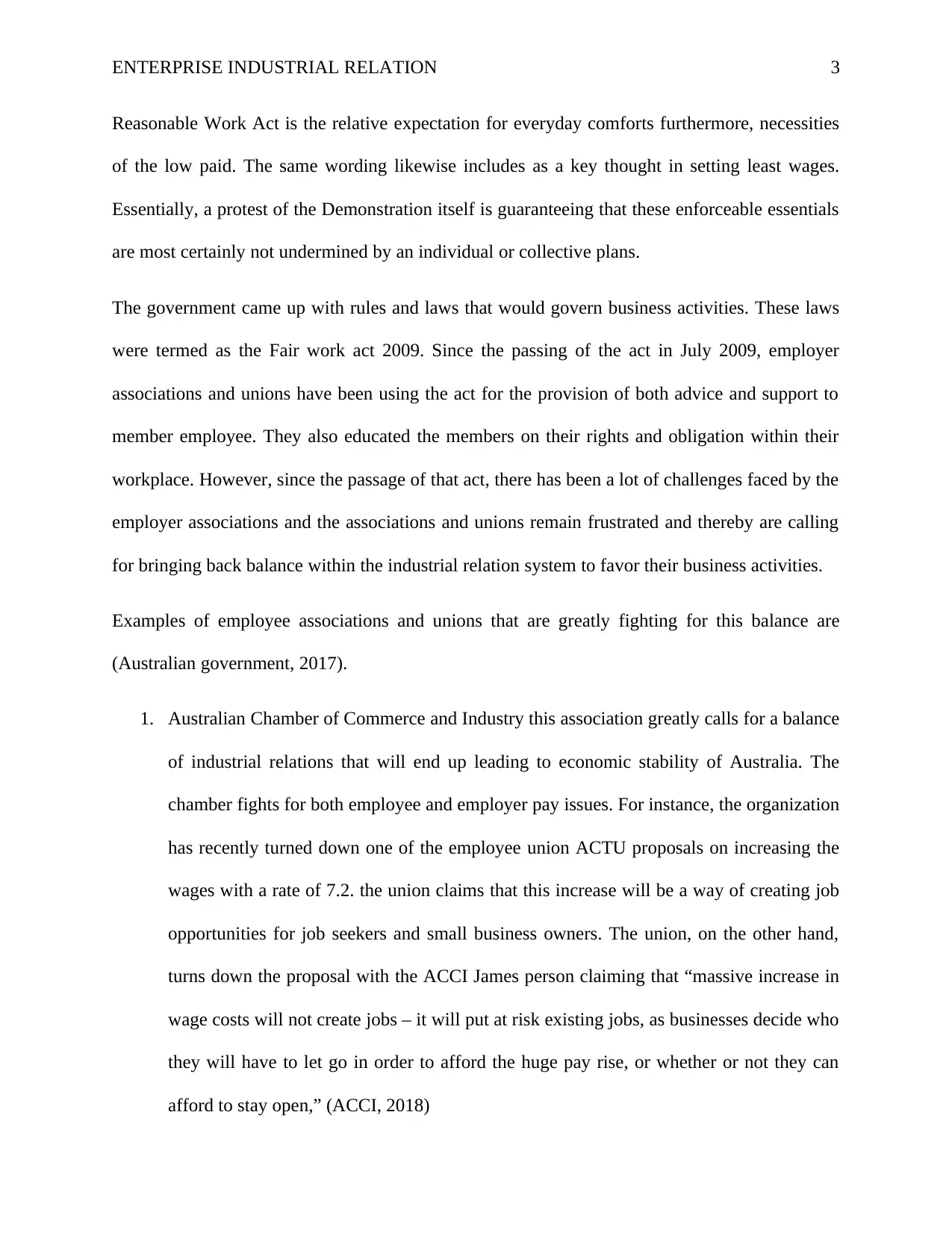
ENTERPRISE INDUSTRIAL RELATION 3
Reasonable Work Act is the relative expectation for everyday comforts furthermore, necessities
of the low paid. The same wording likewise includes as a key thought in setting least wages.
Essentially, a protest of the Demonstration itself is guaranteeing that these enforceable essentials
are most certainly not undermined by an individual or collective plans.
The government came up with rules and laws that would govern business activities. These laws
were termed as the Fair work act 2009. Since the passing of the act in July 2009, employer
associations and unions have been using the act for the provision of both advice and support to
member employee. They also educated the members on their rights and obligation within their
workplace. However, since the passage of that act, there has been a lot of challenges faced by the
employer associations and the associations and unions remain frustrated and thereby are calling
for bringing back balance within the industrial relation system to favor their business activities.
Examples of employee associations and unions that are greatly fighting for this balance are
(Australian government, 2017).
1. Australian Chamber of Commerce and Industry this association greatly calls for a balance
of industrial relations that will end up leading to economic stability of Australia. The
chamber fights for both employee and employer pay issues. For instance, the organization
has recently turned down one of the employee union ACTU proposals on increasing the
wages with a rate of 7.2. the union claims that this increase will be a way of creating job
opportunities for job seekers and small business owners. The union, on the other hand,
turns down the proposal with the ACCI James person claiming that “massive increase in
wage costs will not create jobs – it will put at risk existing jobs, as businesses decide who
they will have to let go in order to afford the huge pay rise, or whether or not they can
afford to stay open,” (ACCI, 2018)
Reasonable Work Act is the relative expectation for everyday comforts furthermore, necessities
of the low paid. The same wording likewise includes as a key thought in setting least wages.
Essentially, a protest of the Demonstration itself is guaranteeing that these enforceable essentials
are most certainly not undermined by an individual or collective plans.
The government came up with rules and laws that would govern business activities. These laws
were termed as the Fair work act 2009. Since the passing of the act in July 2009, employer
associations and unions have been using the act for the provision of both advice and support to
member employee. They also educated the members on their rights and obligation within their
workplace. However, since the passage of that act, there has been a lot of challenges faced by the
employer associations and the associations and unions remain frustrated and thereby are calling
for bringing back balance within the industrial relation system to favor their business activities.
Examples of employee associations and unions that are greatly fighting for this balance are
(Australian government, 2017).
1. Australian Chamber of Commerce and Industry this association greatly calls for a balance
of industrial relations that will end up leading to economic stability of Australia. The
chamber fights for both employee and employer pay issues. For instance, the organization
has recently turned down one of the employee union ACTU proposals on increasing the
wages with a rate of 7.2. the union claims that this increase will be a way of creating job
opportunities for job seekers and small business owners. The union, on the other hand,
turns down the proposal with the ACCI James person claiming that “massive increase in
wage costs will not create jobs – it will put at risk existing jobs, as businesses decide who
they will have to let go in order to afford the huge pay rise, or whether or not they can
afford to stay open,” (ACCI, 2018)
⊘ This is a preview!⊘
Do you want full access?
Subscribe today to unlock all pages.

Trusted by 1+ million students worldwide
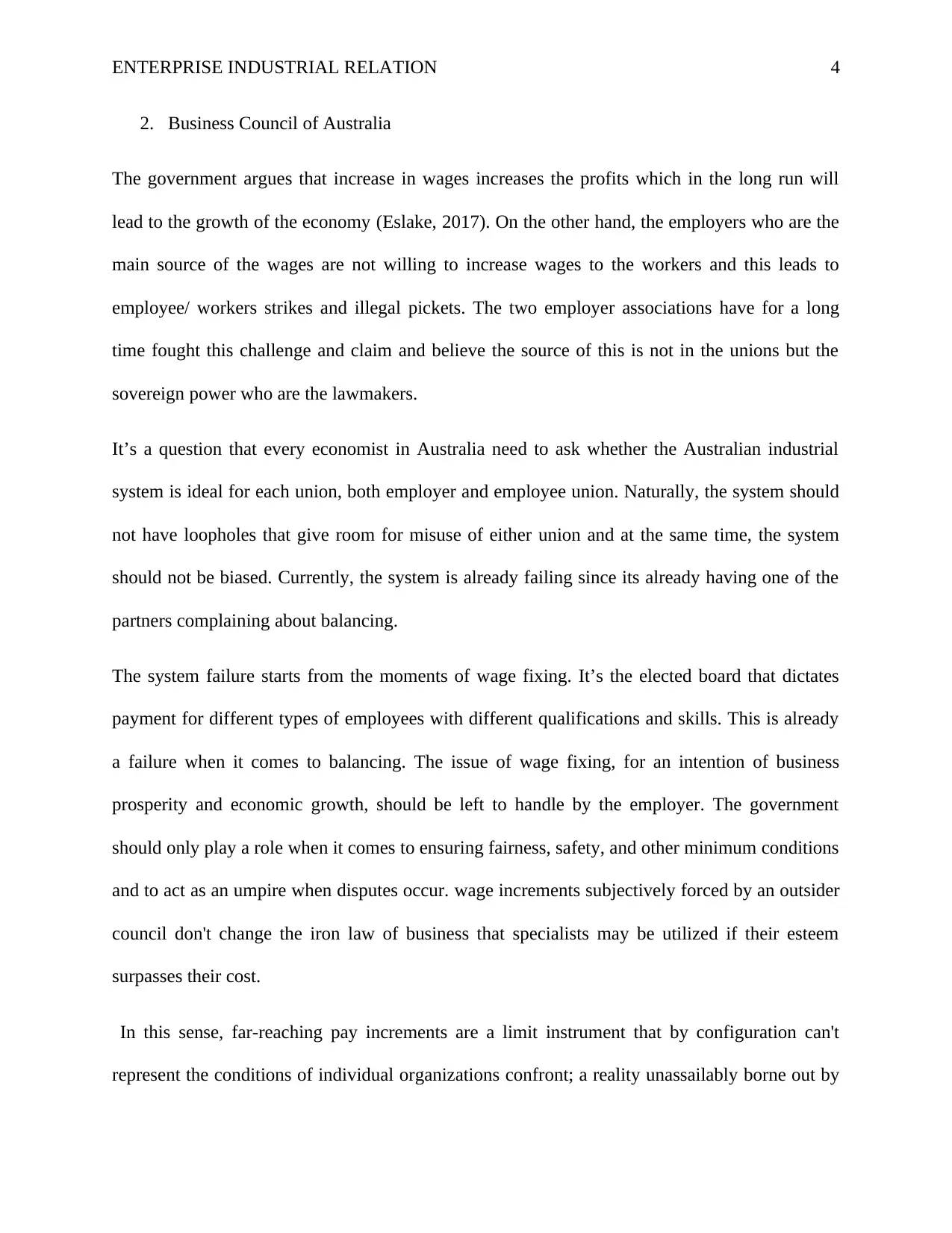
ENTERPRISE INDUSTRIAL RELATION 4
2. Business Council of Australia
The government argues that increase in wages increases the profits which in the long run will
lead to the growth of the economy (Eslake, 2017). On the other hand, the employers who are the
main source of the wages are not willing to increase wages to the workers and this leads to
employee/ workers strikes and illegal pickets. The two employer associations have for a long
time fought this challenge and claim and believe the source of this is not in the unions but the
sovereign power who are the lawmakers.
It’s a question that every economist in Australia need to ask whether the Australian industrial
system is ideal for each union, both employer and employee union. Naturally, the system should
not have loopholes that give room for misuse of either union and at the same time, the system
should not be biased. Currently, the system is already failing since its already having one of the
partners complaining about balancing.
The system failure starts from the moments of wage fixing. It’s the elected board that dictates
payment for different types of employees with different qualifications and skills. This is already
a failure when it comes to balancing. The issue of wage fixing, for an intention of business
prosperity and economic growth, should be left to handle by the employer. The government
should only play a role when it comes to ensuring fairness, safety, and other minimum conditions
and to act as an umpire when disputes occur. wage increments subjectively forced by an outsider
council don't change the iron law of business that specialists may be utilized if their esteem
surpasses their cost.
In this sense, far-reaching pay increments are a limit instrument that by configuration can't
represent the conditions of individual organizations confront; a reality unassailably borne out by
2. Business Council of Australia
The government argues that increase in wages increases the profits which in the long run will
lead to the growth of the economy (Eslake, 2017). On the other hand, the employers who are the
main source of the wages are not willing to increase wages to the workers and this leads to
employee/ workers strikes and illegal pickets. The two employer associations have for a long
time fought this challenge and claim and believe the source of this is not in the unions but the
sovereign power who are the lawmakers.
It’s a question that every economist in Australia need to ask whether the Australian industrial
system is ideal for each union, both employer and employee union. Naturally, the system should
not have loopholes that give room for misuse of either union and at the same time, the system
should not be biased. Currently, the system is already failing since its already having one of the
partners complaining about balancing.
The system failure starts from the moments of wage fixing. It’s the elected board that dictates
payment for different types of employees with different qualifications and skills. This is already
a failure when it comes to balancing. The issue of wage fixing, for an intention of business
prosperity and economic growth, should be left to handle by the employer. The government
should only play a role when it comes to ensuring fairness, safety, and other minimum conditions
and to act as an umpire when disputes occur. wage increments subjectively forced by an outsider
council don't change the iron law of business that specialists may be utilized if their esteem
surpasses their cost.
In this sense, far-reaching pay increments are a limit instrument that by configuration can't
represent the conditions of individual organizations confront; a reality unassailably borne out by
Paraphrase This Document
Need a fresh take? Get an instant paraphrase of this document with our AI Paraphraser
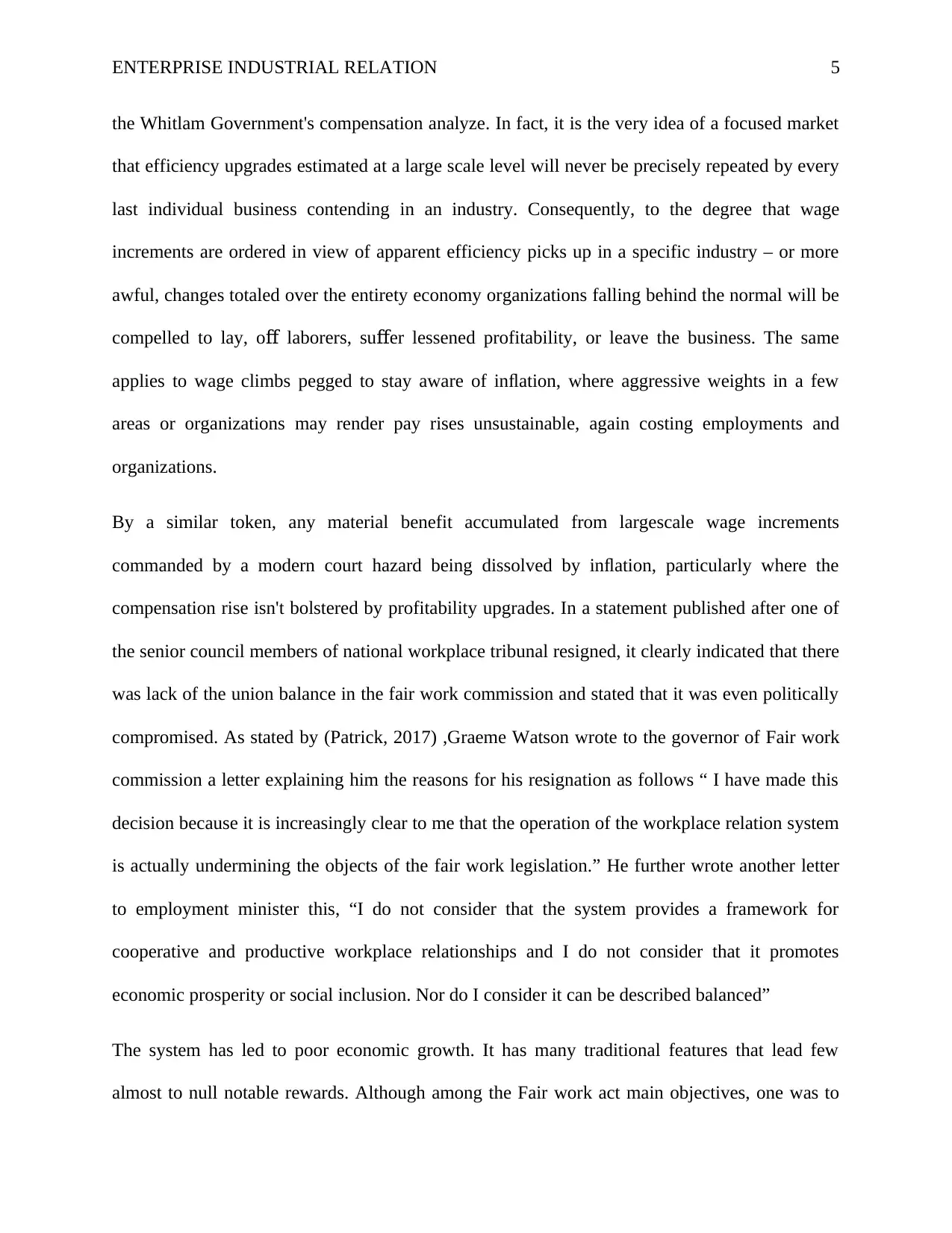
ENTERPRISE INDUSTRIAL RELATION 5
the Whitlam Government's compensation analyze. In fact, it is the very idea of a focused market
that efficiency upgrades estimated at a large scale level will never be precisely repeated by every
last individual business contending in an industry. Consequently, to the degree that wage
increments are ordered in view of apparent efficiency picks up in a specific industry – or more
awful, changes totaled over the entirety economy organizations falling behind the normal will be
compelled to lay, o laborers, su er lessened profitability, or leave the business. The sameff ff
applies to wage climbs pegged to stay aware of inflation, where aggressive weights in a few
areas or organizations may render pay rises unsustainable, again costing employments and
organizations.
By a similar token, any material benefit accumulated from largescale wage increments
commanded by a modern court hazard being dissolved by inflation, particularly where the
compensation rise isn't bolstered by profitability upgrades. In a statement published after one of
the senior council members of national workplace tribunal resigned, it clearly indicated that there
was lack of the union balance in the fair work commission and stated that it was even politically
compromised. As stated by (Patrick, 2017) ,Graeme Watson wrote to the governor of Fair work
commission a letter explaining him the reasons for his resignation as follows “ I have made this
decision because it is increasingly clear to me that the operation of the workplace relation system
is actually undermining the objects of the fair work legislation.” He further wrote another letter
to employment minister this, “I do not consider that the system provides a framework for
cooperative and productive workplace relationships and I do not consider that it promotes
economic prosperity or social inclusion. Nor do I consider it can be described balanced”
The system has led to poor economic growth. It has many traditional features that lead few
almost to null notable rewards. Although among the Fair work act main objectives, one was to
the Whitlam Government's compensation analyze. In fact, it is the very idea of a focused market
that efficiency upgrades estimated at a large scale level will never be precisely repeated by every
last individual business contending in an industry. Consequently, to the degree that wage
increments are ordered in view of apparent efficiency picks up in a specific industry – or more
awful, changes totaled over the entirety economy organizations falling behind the normal will be
compelled to lay, o laborers, su er lessened profitability, or leave the business. The sameff ff
applies to wage climbs pegged to stay aware of inflation, where aggressive weights in a few
areas or organizations may render pay rises unsustainable, again costing employments and
organizations.
By a similar token, any material benefit accumulated from largescale wage increments
commanded by a modern court hazard being dissolved by inflation, particularly where the
compensation rise isn't bolstered by profitability upgrades. In a statement published after one of
the senior council members of national workplace tribunal resigned, it clearly indicated that there
was lack of the union balance in the fair work commission and stated that it was even politically
compromised. As stated by (Patrick, 2017) ,Graeme Watson wrote to the governor of Fair work
commission a letter explaining him the reasons for his resignation as follows “ I have made this
decision because it is increasingly clear to me that the operation of the workplace relation system
is actually undermining the objects of the fair work legislation.” He further wrote another letter
to employment minister this, “I do not consider that the system provides a framework for
cooperative and productive workplace relationships and I do not consider that it promotes
economic prosperity or social inclusion. Nor do I consider it can be described balanced”
The system has led to poor economic growth. It has many traditional features that lead few
almost to null notable rewards. Although among the Fair work act main objectives, one was to
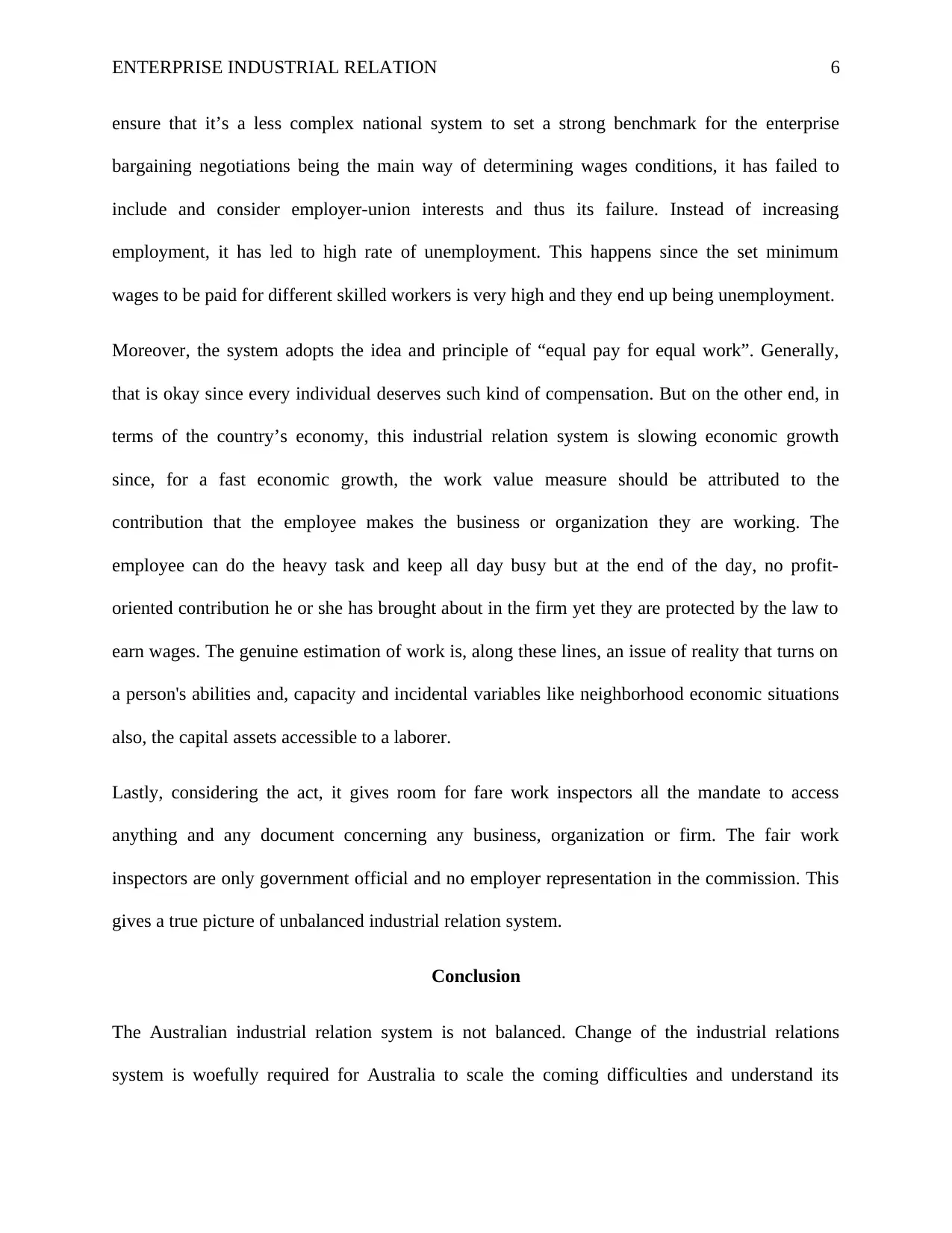
ENTERPRISE INDUSTRIAL RELATION 6
ensure that it’s a less complex national system to set a strong benchmark for the enterprise
bargaining negotiations being the main way of determining wages conditions, it has failed to
include and consider employer-union interests and thus its failure. Instead of increasing
employment, it has led to high rate of unemployment. This happens since the set minimum
wages to be paid for different skilled workers is very high and they end up being unemployment.
Moreover, the system adopts the idea and principle of “equal pay for equal work”. Generally,
that is okay since every individual deserves such kind of compensation. But on the other end, in
terms of the country’s economy, this industrial relation system is slowing economic growth
since, for a fast economic growth, the work value measure should be attributed to the
contribution that the employee makes the business or organization they are working. The
employee can do the heavy task and keep all day busy but at the end of the day, no profit-
oriented contribution he or she has brought about in the firm yet they are protected by the law to
earn wages. The genuine estimation of work is, along these lines, an issue of reality that turns on
a person's abilities and, capacity and incidental variables like neighborhood economic situations
also, the capital assets accessible to a laborer.
Lastly, considering the act, it gives room for fare work inspectors all the mandate to access
anything and any document concerning any business, organization or firm. The fair work
inspectors are only government official and no employer representation in the commission. This
gives a true picture of unbalanced industrial relation system.
Conclusion
The Australian industrial relation system is not balanced. Change of the industrial relations
system is woefully required for Australia to scale the coming difficulties and understand its
ensure that it’s a less complex national system to set a strong benchmark for the enterprise
bargaining negotiations being the main way of determining wages conditions, it has failed to
include and consider employer-union interests and thus its failure. Instead of increasing
employment, it has led to high rate of unemployment. This happens since the set minimum
wages to be paid for different skilled workers is very high and they end up being unemployment.
Moreover, the system adopts the idea and principle of “equal pay for equal work”. Generally,
that is okay since every individual deserves such kind of compensation. But on the other end, in
terms of the country’s economy, this industrial relation system is slowing economic growth
since, for a fast economic growth, the work value measure should be attributed to the
contribution that the employee makes the business or organization they are working. The
employee can do the heavy task and keep all day busy but at the end of the day, no profit-
oriented contribution he or she has brought about in the firm yet they are protected by the law to
earn wages. The genuine estimation of work is, along these lines, an issue of reality that turns on
a person's abilities and, capacity and incidental variables like neighborhood economic situations
also, the capital assets accessible to a laborer.
Lastly, considering the act, it gives room for fare work inspectors all the mandate to access
anything and any document concerning any business, organization or firm. The fair work
inspectors are only government official and no employer representation in the commission. This
gives a true picture of unbalanced industrial relation system.
Conclusion
The Australian industrial relation system is not balanced. Change of the industrial relations
system is woefully required for Australia to scale the coming difficulties and understand its
⊘ This is a preview!⊘
Do you want full access?
Subscribe today to unlock all pages.

Trusted by 1+ million students worldwide
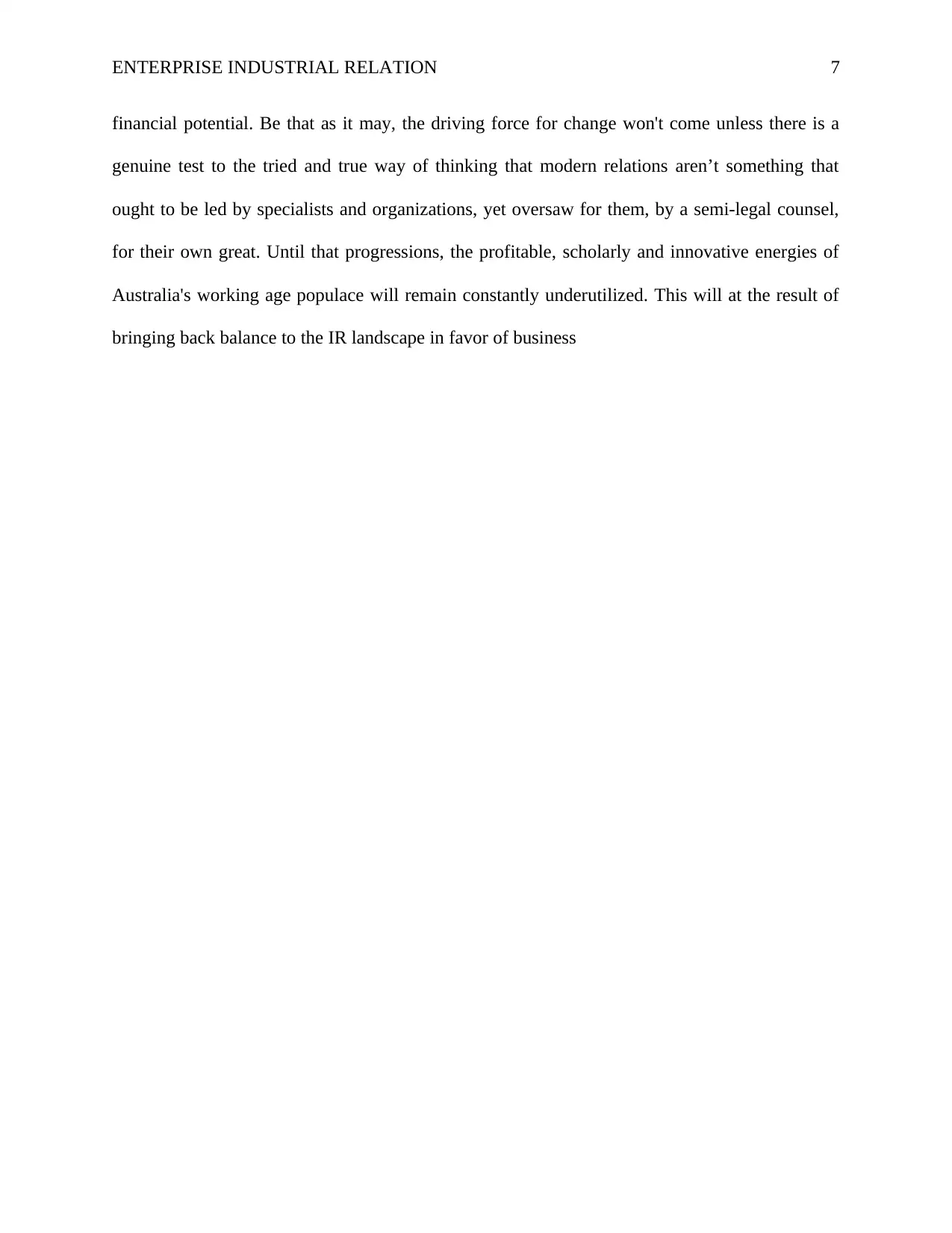
ENTERPRISE INDUSTRIAL RELATION 7
financial potential. Be that as it may, the driving force for change won't come unless there is a
genuine test to the tried and true way of thinking that modern relations aren’t something that
ought to be led by specialists and organizations, yet oversaw for them, by a semi-legal counsel,
for their own great. Until that progressions, the profitable, scholarly and innovative energies of
Australia's working age populace will remain constantly underutilized. This will at the result of
bringing back balance to the IR landscape in favor of business
financial potential. Be that as it may, the driving force for change won't come unless there is a
genuine test to the tried and true way of thinking that modern relations aren’t something that
ought to be led by specialists and organizations, yet oversaw for them, by a semi-legal counsel,
for their own great. Until that progressions, the profitable, scholarly and innovative energies of
Australia's working age populace will remain constantly underutilized. This will at the result of
bringing back balance to the IR landscape in favor of business
Paraphrase This Document
Need a fresh take? Get an instant paraphrase of this document with our AI Paraphraser
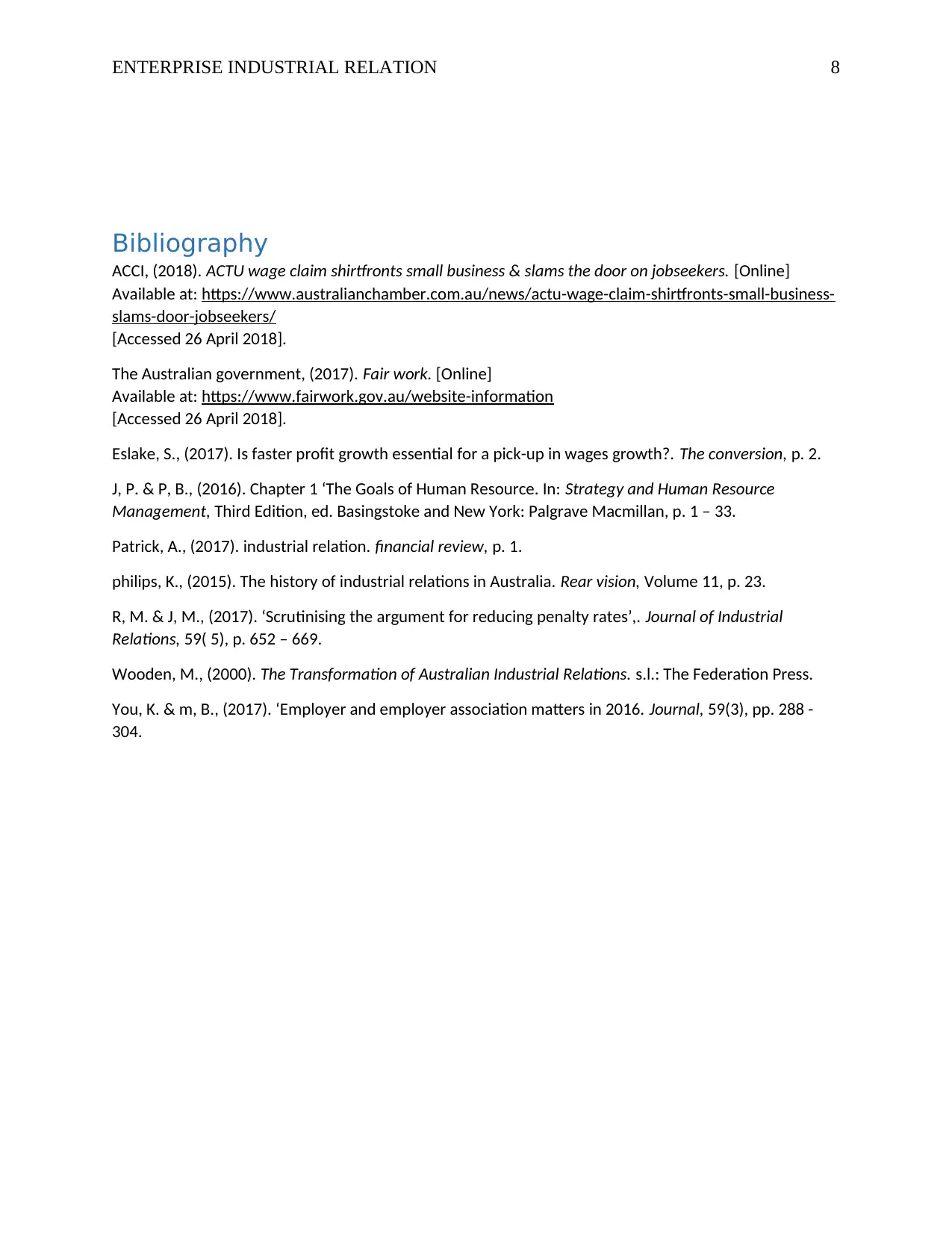
ENTERPRISE INDUSTRIAL RELATION 8
Bibliography
ACCI, (2018). ACTU wage claim shirtfronts small business & slams the door on jobseekers. [Online]
Available at: https://www.australianchamber.com.au/news/actu-wage-claim-shirtfronts-small-business-
slams-door-jobseekers/
[Accessed 26 April 2018].
The Australian government, (2017). Fair work. [Online]
Available at: https://www.fairwork.gov.au/website-information
[Accessed 26 April 2018].
Eslake, S., (2017). Is faster profit growth essential for a pick-up in wages growth?. The conversion, p. 2.
J, P. & P, B., (2016). Chapter 1 ‘The Goals of Human Resource. In: Strategy and Human Resource
Management, Third Edition, ed. Basingstoke and New York: Palgrave Macmillan, p. 1 – 33.
Patrick, A., (2017). industrial relation. financial review, p. 1.
philips, K., (2015). The history of industrial relations in Australia. Rear vision, Volume 11, p. 23.
R, M. & J, M., (2017). ‘Scrutinising the argument for reducing penalty rates’,. Journal of Industrial
Relations, 59( 5), p. 652 – 669.
Wooden, M., (2000). The Transformation of Australian Industrial Relations. s.l.: The Federation Press.
You, K. & m, B., (2017). ‘Employer and employer association matters in 2016. Journal, 59(3), pp. 288 -
304.
Bibliography
ACCI, (2018). ACTU wage claim shirtfronts small business & slams the door on jobseekers. [Online]
Available at: https://www.australianchamber.com.au/news/actu-wage-claim-shirtfronts-small-business-
slams-door-jobseekers/
[Accessed 26 April 2018].
The Australian government, (2017). Fair work. [Online]
Available at: https://www.fairwork.gov.au/website-information
[Accessed 26 April 2018].
Eslake, S., (2017). Is faster profit growth essential for a pick-up in wages growth?. The conversion, p. 2.
J, P. & P, B., (2016). Chapter 1 ‘The Goals of Human Resource. In: Strategy and Human Resource
Management, Third Edition, ed. Basingstoke and New York: Palgrave Macmillan, p. 1 – 33.
Patrick, A., (2017). industrial relation. financial review, p. 1.
philips, K., (2015). The history of industrial relations in Australia. Rear vision, Volume 11, p. 23.
R, M. & J, M., (2017). ‘Scrutinising the argument for reducing penalty rates’,. Journal of Industrial
Relations, 59( 5), p. 652 – 669.
Wooden, M., (2000). The Transformation of Australian Industrial Relations. s.l.: The Federation Press.
You, K. & m, B., (2017). ‘Employer and employer association matters in 2016. Journal, 59(3), pp. 288 -
304.
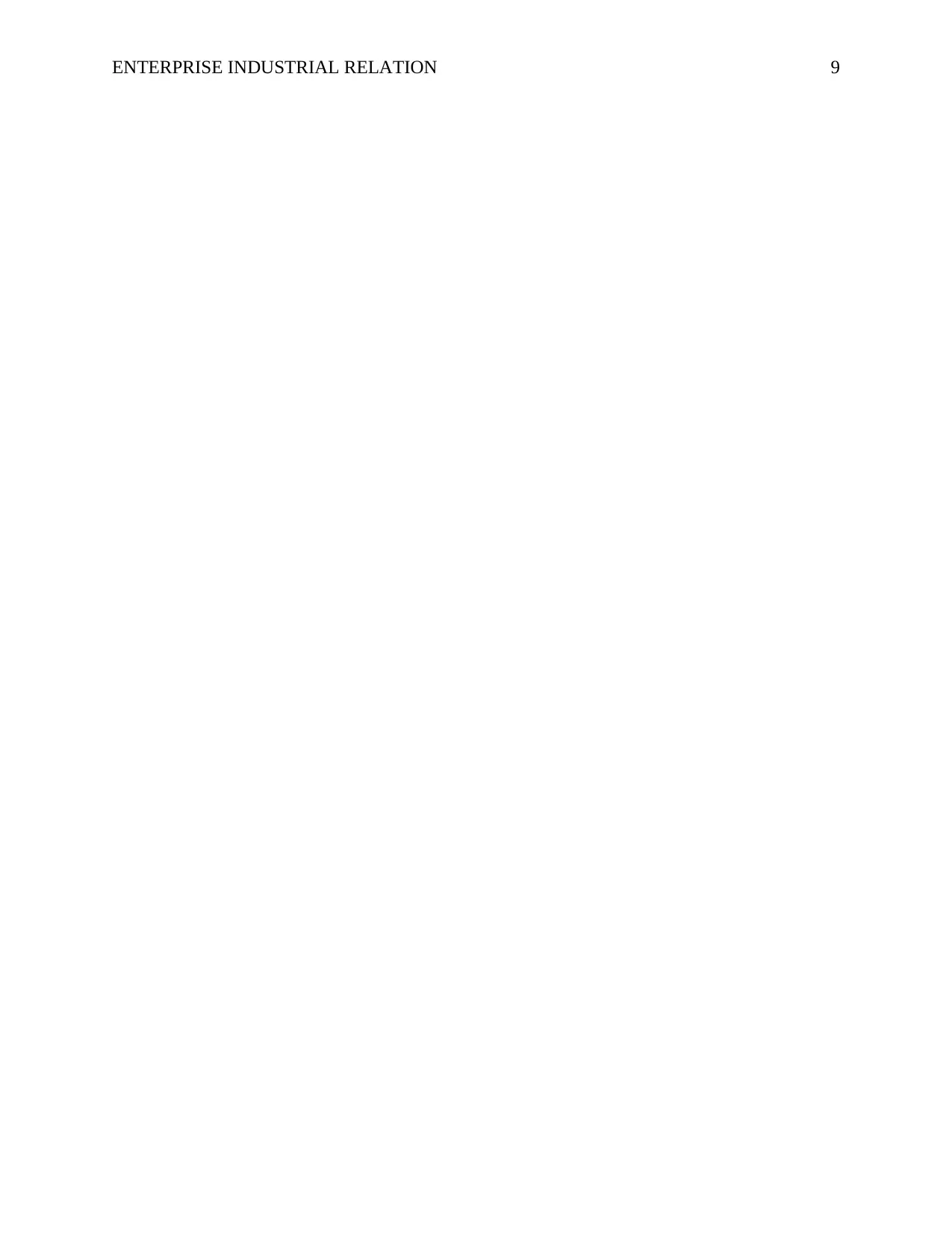
ENTERPRISE INDUSTRIAL RELATION 9
⊘ This is a preview!⊘
Do you want full access?
Subscribe today to unlock all pages.

Trusted by 1+ million students worldwide
1 out of 9
Related Documents
Your All-in-One AI-Powered Toolkit for Academic Success.
+13062052269
info@desklib.com
Available 24*7 on WhatsApp / Email
![[object Object]](/_next/static/media/star-bottom.7253800d.svg)
Unlock your academic potential
Copyright © 2020–2025 A2Z Services. All Rights Reserved. Developed and managed by ZUCOL.





